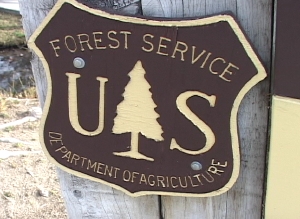 Forest Review Plan Update Held in Bishop – Sierra Wave
Forest Review Plan Update Held in Bishop – Sierra Wave
By Charles James (News Staff)
28 August 2013
The Inyo County Board of Supervisors wrapped up several weeks of what must have been exhausting public meetings held throughout the county, including a meeting in Bishop at the City Council Chambers on the Inyo Forest Plan Update Review. There was a good turnout as far as public meetings have gone recently with about 20 local residents showing up and a good half of them offering criticism of the Forest Service.
The original Inyo Forest Plan dates back to 1988. It has been 25 years since a major revision has been undertaken, although there have been amendments reflecting changes in conditions over time.
Given the criticism directed at the Forest Service at the Bishop meeting, 25 years haven’t much improved the public’s trust of the federal agency. The speakers were uniformly critical of the agency, characterizing it as an unreliable partner that often uses intimidating, confusing terminology, and has a lack of understanding and competence in predicting the negative economic consequences that its policies have on local communities.
Inyo County Planning Director Joshua Hart began the meeting by giving a brief overview of the 15 Topic Papers that form the basis of the Inyo Forest Plan. There were three top priorities – access, a vibrant economy, and the protection of local culture. He then turned the meeting over to Inyo Forest Planner Susan Joyce who spoke on the purpose of the plan.
She said, “Forest Plans are intended to provide direction for a ten to fifteen year planning period. Amendments are made and are limited or specific in terms of the management direction that was changed. The Inyo National Forest Plan offers a broad policy decision-making tool that does not permit specific action or activity. It sets goals and objectives for “desired conditions,” explained Joyce.
The Final Forest Plan isn’t expected to be completed until 2016. It is the Board of Supervisors that must make recommendations during the planning process which is why they held public meetings to find out what the public wants and thinks on the subject. Supervisor Linda Arcularius reminded the audience that the forest service representatives were invited “guests” and the board appreciated their coming to the meeting.
Greg Weirick was first to speak to the board, saying “I would like to caution the board about the lack of collaboration when dealing with the Forest Service.” He said, “They use terminology that is deliberately confusing and intimidating.” He asked the board to look at the National Visitor Use Monitoring Program (NVUM) that he says, “uses surveys that are designed to get the data they want to meet their own agenda.”
Dick Noles followed by thanking the Board of Supervisors for holding the meeting and identified access as being critical. He said, “Keeping the forest open to everyone is vitally important” and agreed with Weirick that the terminology used by the Forest Service leaves the public feeling “they are being had”. He ended by saying, “The forest−we own it. They don’t.”
The next speaker, Steve Toomey, spoke about how important the plan is because it is always quoted in future document. “It’s about the economics and it’s tough right now.” Fifth District Supervisor Matt Kingsley agreed, saying “The Board of Supervisors’ public meetings on the forest plan are indicative of our interest of its importance.”
“I don’t want to see us locked out of the forest,” said Doug Brown, who was followed by Ken Lloyd. Lloyd started out saying that he has been in Inyo County for 70 years, and that “The Forest Service has no mentality for multi-use− and mining needs to be addressed.” He claimed that “They do not care about the people of Inyo and Mono Counties or any of the Eastern Sierra” and noted that bonds for operating mines having been doubled over the years, making it very difficult to operate mines.
“It’s easy to get a defeatist attitude when dealing with the Forest Service,” said David Tanksley. “The Forest Service doesn’t have the staff to look at the economic impacts of their decisions and policies.” He added that roads are needed for mineral access, mineralization zones for extractive purposes on private property, and access through forest land.” He asked the board to look at the land-trade ratio which he says is ridiculous.
Joyce from the Forest Service offered information that the Forest Service recognizes the effects of its policies on local economies and they have hired an economist, Mark Metcalf, who is currently working in Vallejo, to do an economic analysis for the Inyo, Sequoia, and White Mountains.
Local scientist John Shepard cautioned that “sustainability needs to be looked at,” observing that “Unlike cattle, logging, or grass, minerals cannot be sustained. Once they are gone, they are gone.” Again on sustainability, he posited, “If we have more roads, for example, can they be maintained?”
Concern over lawsuits was offered by Howard Arcularius, noting that they often stymie economic progress. Mike Johnston followed and expressed dismay over the Forestry Partnership Program, which he says has not worked well for the Big Pine, Aspen, and South Fork communities.
Fourth District Supervisor Mark Tillemans was optimistic and said that county staff is ahead of the issues. And District Supervisor Matt Kingsley noted that, “Our small communities’ futures are tied to the federal agencies. We need to make sure our needs here are not lumped in with those on the west side of the mountains,” and that he supports multiple-use and management of the forest that is sustainable.
Jeff Griffiths, Second District Supervisor, agreed on the multiple-use policy. “This is a long process and it can be tiresome,” he cautioned, “We need to make sure our comments are effective; and that the final plan reflects the uses locals want to have.”
September 1 is the deadline for comments on the forest plan to the county. Arcularius thanked the public for attended and noted that public meetings hosted by the Forest Service will follow in the upcoming months.
















